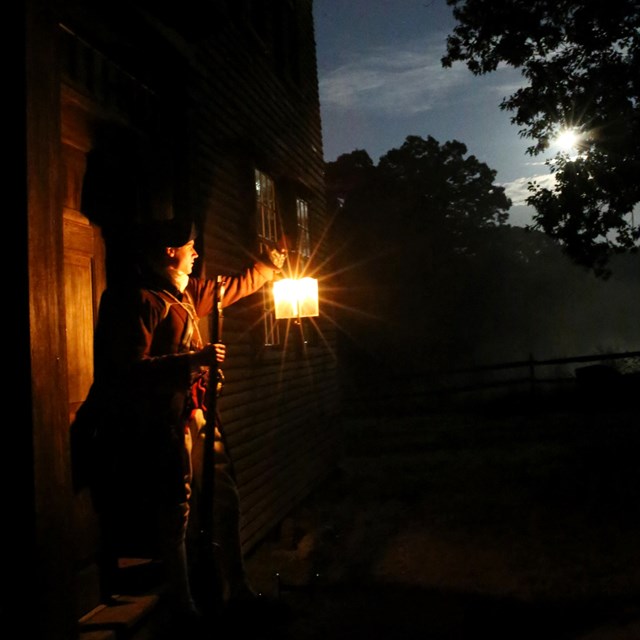
NPS Photo

Geography:The Bloody Bluff battle site in Minute Man National Historical Park is a story 600 million years in the making and demonstrates the awesome power of continental collision. The story of the bluff began 600 million years ago, when there were only two large continents on earth: Gondwana (made up of Africa, Australia, Antarctica, India and South America) and Laurasia (made up of North America, Eurasia and Greenland). Around that time, two volcanic chains formed off the north coast of ancient Gondwana. Within these volcanic chains were distinct magma chambers, deep below the earth’s surface. When this magma solidified it formed vast stretches of underground rock at the heart of the two island chains; the older Avalon terrane, and the younger Nashoba terrane. Eventually the younger Nashoba terrane separated from the continent of Gondwana and moved towards the continent of Laurasia, the ancient North American coast. When the Nashoba terrane collided, it sutured with ancient North America. About 20 million years later, the Avalon terrane also followed suit and collided with the Nashoba Terrane rocks. This caused the continent to grow larger, and mountains to rise. This is a process called terrane accretion, where island terranes smash into the edge of continents. The “Bloody Bluff,” a rock outcrop within Minute Man NHP shows the contact point between the Nashoba terrane and the Avalon terrane—the point where two worlds collided millions of years ago. By examining evidence such as this outcrop, scientists can reconstruct ancient conditions of the landscape. It is now thought that at one point the crust was nine miles thicker than it is today—meaning that there were once grand mountains within the park long ago. Click Here To Learn More About The Geology Of Minute Man National Historical Park Early History:The Bluff has historical significance starting much earlier than April 19, 1775. Human inhabitation of this region dates back over twelve thousand years and by the early seventeenth century Algonquian people had been living along the Musketequid River (Concord River) for about a thousand years. Before contact with Europeans these indigenous peoples hunted large game in the surrounding forests including those that covered the modern-day bluff. When puritan families ventured inland around 1635, they claimed the prosperous land along the Musketequid River as their own. In a short time, Europeans cleared large tracts of forest to establish Concord Plantation, now Concord, Massachusetts. In the area of the Bluff, the colonists worked to replace forests with farm fields and animal pasture. While most rocky outcrops became farm walls, the scale of the bluff hindered any significant restructuring during the early colonial period. By the mid-18th century the bluff was likely a wooded outcrop owned by the Whittemore family. While the steep cliff face posed a challenge for agricultural endeavors, the Whittemore’s allowed the striking hilltop to grow a thick coverage of trees. During the early colonial period, the local community constructed a road running through the region and took special care to wrap it around the base of the bluff as opposed to going over it. Eventually the road to Concord Plantation became the Bay Road 
Historical Image in Minute Man National Historical Park Archival Collection April 19, 1775:On the morning of April 19, 1775, seven-hundred British soldiers passed the bluff on their march to raid military stockpiles in Concord. Later that day the same British column, excluding scores of casualties, fought a short rear-guard action on the bluff to cover their hasty retreat to Boston. 
NPS Photo With over a thousand Colonial militia quickly closing on the column, the British rear-guard passed the Whittemore house and the Bull Tavern before ascending the sloped sides of the bluff. From this commanding viewpoint covered by trees the Regulars watched Colonial militia advance to the tavern, a building that Reading militia man Rev. Edmund Foster knew as “Benjamin’s Tavern.” The British rear-guard then opened fire from the high ground at the bluff and covered the lead elements of their column now ascending Fiske hill. Rev. Edmund Foster with the Reading militia near the Tavern recalled,
Dramatically outnumbered and flanked the British detachment atop the bluff withdrew. As the regulars descended the rocky hillside into the low area behind, more colonial militia hidden behind trees, rocks and fence rails on Fiske Hill opened fire. Desperately attempting to protect the column and cover the retreat, a mounted British officer galloped to the front. Edmund Foster continued,
Colonial militia quickly stripped the horse of the officers effects, finding a beautiful brace of engraved pistols. At the time, the militia claimed their prize belonged to Col. Pitcairn commanding the detachment of British Marines, however recent scholarship indicates the pistols instead belonged to another British officer, Captain William Crosbie of the 38th Regiment’s grenadier company, wounded on April 19, 1775. The Changing Landscape:
NPS Photo During the 19th and 20th centuries the bluff and surrounding landscape underwent many changes. In the New Republic era additional farmhouses dotted the landscape and new businesses appeared driving up local travel. In 1802 and 1806 portions of the Battle Road were straightened and some new segments by-passed historic sites. In the area of the bluff, a newly constructed road by-passed areas such as the Nelson farms and accommodated increased traffic. Directly at the base of the bluff the new road intersected with the historic Bay Road, now called Massachusetts avenue. In addition, the landscape evolved when a larger tavern replaced the historic Bull’s Tavern. Construction workers also quarried rocks from the hillside east of the bluff throughout the 19th century for various projects. Although altered, the bluff remained a source of local legend concerning April 19, 1775. In 1885 residents erected a small monument at the base of the bluff to commemorate the revolutionary history of the site. Coburn, Frank Warren, 1853-1923. The Battle of April 19, 1775: In Lexington, Concord, Lincoln, Arlington, Cambridge, Somerville, And Charlestown, Massachusetts. 2d ed., rev. and with additions. Lexington, Mass.: The Lexington historical society, 1922.
Dietrich-Smith D. 2005. Battle Road Unit: Cultural Landscape Report, Minute Man National Historical Park, National Park Service. Cultural Landscape Report. National Park Service, Northeast Regional Office; Olmsted Center for Landscape Preservation. Northeast Regional Office Douglas Sabin, April 19, 1775: A Historiographical Study, (Minute Man National Historical Park, Concord, 1987). Kehoe, Vincent J-R. 1974. "We were there!": April 19th 1775. [Chelmsford, Mass.]: [The author]. NPS Northeast Regional Office. 2012. Nelson Farm Area: Cultural Landscape Inventory, Minute Man National Historical Park, National Park Service. Cultural Landscapes Inventory reports. 650043. Northeast Regional Office/ CLI Database Rev. Edmund Foster quoted in Rev. Ezra Ripley, A History of the Fight at Concord, (Allen and Atwell, Concord, 1827), 32-33. Continue The Story: |
Last updated: November 30, 2021



